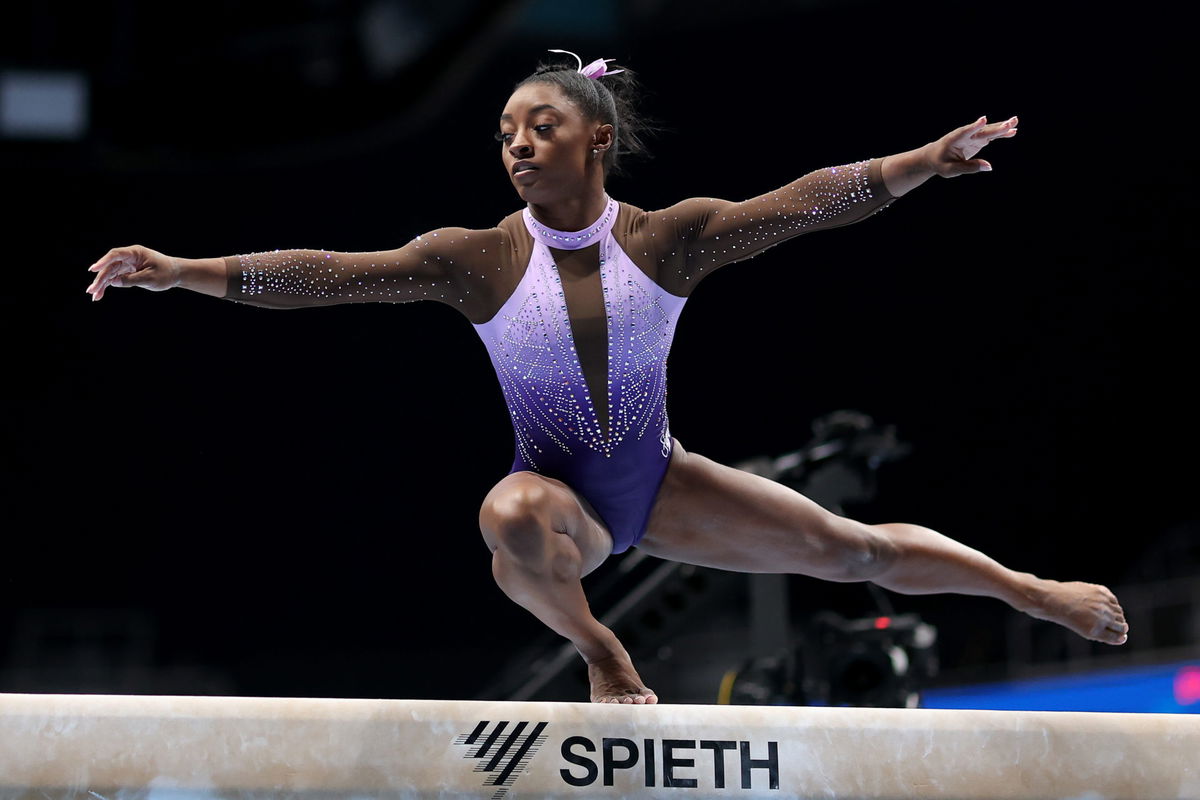

Gymnastics is a captivating sport in which athletes gracefully and precisely accomplish feats that defy gravity. Yet beneath these dazzling routines are intricate scoring systems that determine the success of these poised athletes in the gymnastics world. These scoring systems have evolved from junior gymnastics to collegiate athletics to the top of elite competitions and the biggest stage of them all, the Olympics.
Watch What’s Trending Now!
This in turn has highlighted the development of the sport and the extraordinary skills of athletes like Simone Biles. This sport is made even more exciting by an understanding of gymnastics scoring and an exploration of the dizzying heights of difficulty scores that distinguish these athletes.
ADVERTISEMENT
Scoring system at junior levels in gymnastics
Before reaching great heights in Collegiate Level Gymnastics and Elite Level Gymnastics? many aspiring gymnasts first participate in the USA Gymnastics Junior Olympic (J.O.) program. The levels 4 through 10 of this program represent the different skill levels, with level 10 being the highest level.
The J.O. Code of Points is a thorough framework that changes every four years to promote gymnastics’ growth and advancement and is used to evaluate the scoring system at these levels.
Top Stories
Sean Payton Announces Retirement Plans as Broncos HC Demands Improvement From Bo Nix & Co. Before Playoffs

Greg Biffle’s $4M Worth Prized Possession Still Without a Buyer Leaves NASCAR Fans Heartbroken

LIV Golf Braces for Another Possible Exit in Wake of Brooks Koepka Departure

Biff Poggi All But Confirms Bryce Underwood’s Michigan Future After Announcing His Own Departure

Roger Federer Draws Criticism from Swiss Government Chief for Tourism Boom in Country

NASCAR World Mourns as Former Watkins Glen President Michael Printup Passes Away at 60

One fundamental distinction between each level lies in the difficulty of elements and their connections performed. Meeting the requirements to advance to each level depends on the complexity of the skills and execution of them performed. The Code of Points outlines the difficulty requirements for each level, making sure the integrity of the sport is maintained and that there is a smooth transition between them.
ADVERTISEMENT

Getty
SAN JOSE, CALIFORNIA – AUGUST 27: Suni Lee competes in the balance beam on day four of the 2023 U.S. Gymnastics Championships at SAP Center on August 27, 2023 in San Jose, California. (Photo by Ezra Shaw/Getty Images)
For instance, achieving level 10 means executing more challenging skills compared to level 9. The introduction of complex skills and their performance leads to the accumulation of “bonus points,” aiming for a higher starting score of 10.0. This starting score provides a cushion against deductions, which is a desirable goal for gymnasts. In gymnastics, deductions are part and parcel of every routine. While there are numerous deductions, some are more common than others and can significantly impact a gymnast’s final score. A few of the common deductions seen are:
ADVERTISEMENT
Flexed Feet (each time): Deduction of 0.05 points for each instance of flexed feet.
Bent Legs: Deduction of up to 0.3 points for bent legs during skills.
Legs Crossed While Twisting: Deduction of up to 0.10 points for crossing legs while twisting.
ADVERTISEMENT
Wobbles on Beam: Deduction of up to 0.3 points for balance wobbles.
Fall (any event): Deduction of 0.5 points for falling during a routine.
Slight Hop on Landing: Deduction of up to 0.10 points for a minor hop on landing.
ADVERTISEMENT
Steps on Landing: Deduction of 0.10 points for each step taken on landing.
Tumbling Out of Bounds: Deduction of 0.1 points for going out of bounds during tumbling.
Beyond these objective deductions, there are also subjective penalties, such as “insufficient sureness of performance throughout the exercise on beam” (up to a 0.2 tenth deduction) and “quality of movement to reflect personal style on floor” (up to a 0.3 tenth deduction). These subjective elements add an element of unpredictability to J.O. scoring, even for seasoned gymnastics enthusiasts.
ADVERTISEMENT
During regular season meets, two judges independently score each routine. The gymnast’s final score is determined by averaging both judges’ scores. If the judges’ scores initially differ by more than three-tenths, they are required to confer and reach a consensus on a score within that range. In Junior Olympic Level scoring, only two judges evaluate each routine. Both judges assess the difficulty of the routine individually, subtracting any deductions. The gymnast’s final score is the average of these two judges’ scores, with a maximum possible score of 10.
NCAA divisions scoring system
In the world of college gymnastics, there are three distinct divisions?Division I, Division II, and Division III?that offer varying scholarships to their gymnasts. Division I (DI) programs typically offer the most athletic aid, though exceptions apply to Ivy League schools and service academies with unique scholarship rules.
ADVERTISEMENT
Division II (DII) programs provide about half the scholarships of DI teams, while Division III (DIII) doesn’t offer any athletic scholarships. Across all three divisions, gymnasts compete under J.O. level 10 rules with NCAA “Rules Modifications.” These streamlined rules omit certain complexities, like strict balance criteria on the beam. This refinement, coupled with the high standard of form seen in top DI teams, leads to notably higher scores than in J.O. gymnastics, even including occasional perfect 10s.

Getty
LIVERPOOL, ENGLAND – October 29: Jordan Chiles of the United States performs her floor routine during Women’s qualifications at the World Gymnastics Championships-Liverpool 2022 at M&S Bank Arena on October 29th, 2022 in Liverpool, England. (Photo by Tim Clayton/Corbis via Getty Images)
College gymnastics, however, still allows for mistakes that can result in deductions, specifically in the areas of floor landings, beam, vault, and bar landings, handstands, amplitude on vault, splits on beam and floor, wobbles on beam, and amplitude and rotation on the floor.
ADVERTISEMENT
Start values are crucial in college gymnastics, starting at 9.500 and requiring gymnasts to earn bonus points for higher scores. They become even more significant as scores narrow in NCAA gymnastics. A small difference in start value can impact championship meets.
Unlike the individual nature of J.O. gymnastics, NCAA gymnastics is a team sport. Teams field six gymnasts per event, with the top five scores counting. The lowest score on each event is dropped, and the combined event scores make up the team’s final score.
The highest possible team score is 200, but top DI teams typically score in the 197 to 198 range. Scores vary across divisions, with DI attracting top talent due to more extensive athletic aid. Controversies also exist, particularly in DII and DIII, regarding scoring methods compared to J.O. level 10 routines, sans NCAA modifications.
Olympic and Elite level scoring system
Beyond level 10, talented gymnasts can ascend to the U.S. Elite program, where they prepare for international competitions, often trading traditional schooling for full-time training. However, perfection eludes them in elite gymnastics due to a scoring system overhaul by the International Gymnastics Federation (FIG) in 2006.
Elite gymnastics ditches the perfect 10. Scores are now divided into two parts: the Difficulty (“D”) Score, encompassing connection value and skill difficulty, and the Execution (“E”) Score, which starts at 10 and drops with form penalties. The FIG Code is more stringent than the J.O. Code, with a fall costing a whole point, not just five tenths. Elite gymnasts must stick every tumbling pass, using leaps or jumps to maintain control.

Imago
Gymnastics – Artistic Gymnastics World Championships – Women s Individual All-Around Final Shilese Jones USA beam during Artistic Gymnastics World Championships – Women s Individual All-Around Final, Gymnastics in Liverpool, England, November 03 2022 Liverpool M&S Bank Arena England Copyright: xFilippoxTomasix/xLiveMediax
Unlike J.O., elite gymnastics has no upper limit for the D Score. More difficulty means a higher D Score. Elite gymnasts string skills together for more difficulty, but wobbles break connections and cost difficulty points.
On floor, they perform four tumbling passes to maximize difficulty opportunities.? Elite gymnasts typically score 15.000 or higher, while lower podium positions aim for the mid-14.0 range. Gymnasts at top international competitions target scores in the high 14s to 15s, with occasional 16s for world-class routines. So even lower-scoring elite gymnasts attract top NCAA programs, thanks to their exceptional skills and form.
Olympic gymnastics employs a three-panel judging system: the D Panel for the Difficulty Score, the E Panel for the Execution Score, and the Reference Panel to correct Execution Score issues.
How Scoring Works
The Difficulty Score starts at 0 and depends on skills and connections in a routine. The Execution Score starts at 10.0, with deductions for errors. The final score, according to the current Code of Points, ranges from 13 to 16 points.
Difficulty Score
Two D Panel judges calculate it by assessing the routine’s difficulty. The highest and lowest scores are discarded, and a consensus establishes the Difficulty Score. Elements must align with the Code of Points, and skill values are outlined.
Execution Score
Five E Panel judges determine it. The highest and lowest scores are dropped, and the remaining three are averaged. This score reflects execution and artistry, with deductions for falls, technique errors, and execution, ranging from 0.1 to 1.0.
Neutral Deductions
These penalize errors like time violations, stepping out of bounds, behavior faults, or falls. Falls result in a 1.0 deduction.
Inquiries
Gymnasts can challenge scores through inquiry, involving verbal and written components, typically after their score is posted but before the next gymnast’s routine. Inquiries may lead to score adjustments.
International Gymnastics Scoring
Top gymnasts often score in the high 14s to 15s at international competitions, with the occasional 16 for outstanding routines.
The highest score a gymnast can achieve
In the world of elite gymnastics, the concept of the “perfect 10” has evolved into something far more intricate. In today’s gymnastics scoring system, a gymnast’s performance is assessed using a multifaceted approach, encompassing both the difficulty and execution of their skills.
The spotlight often shines brightest on the difficulty score, especially in the era of Simone Biles, whose routines are packed with technical skills, resulting in stratospheric difficulty scores that seem almost unbeatable. So, just how high can these difficulty scores ascend? USA Gymnastics offers insights into the calculation of the difficulty score.

Getty
STUTTGART, GERMANY – OCTOBER 13: Simone Biles of The United States poses for photos with her multiple gold medals during day 10 of the 49th FIG Artistic Gymnastics World Championships at Hanns-Martin-Schleyer-Halle on October 13, 2019 in Stuttgart, Germany. (Photo by Laurence Griffiths/Getty Images)
For each routine, the difficulty score is determined by summing up: The point value of the 10 most challenging skills executed in the routine, with each skill, counted only once, the Connection value is earned by successfully linking multiple skills consecutively. Composition requirements allow athletes to accumulate up to 2.0 points by performing a set of mandated elements specific to the apparatus.
Women’s gymnastics assigns each skill to one of 10 classifications, each carrying a progressively higher point value as it becomes more demanding. These classifications, known as Group A through Group J, range from 0.1 points for Group A skills to 1.0 points for Group J skills. Vault skills are evaluated slightly differently, with current difficulty values ranging from 2.0 to 6.4 points.
To underscore Simone Biles’s exceptional performance, consider her triple-double on-the-floor exercise, currently the sole J-level element. Moreover, her latest vault, the Yurchenko double pike, has been provisionally valued at a remarkable 6.6 points at the GK US Classic. In practical terms, there is no upper limit for the difficulty score, though in elite gymnastics, difficulty scores, often referred to as “D-scores,” typically fall between 5 and 6 points.
Read more: Simone Biles? Yurchenko Double Pike Vault Controversy Explained
This scoring system, though occasionally complex for viewers, has enabled athletes to continually push the boundaries of the sport, delivering awe-inspiring performances that captivate audiences worldwide.
Watch this story: Inching Closer to Simone Biles and Shilese Jones, Gymnastics? Rising Star Unveils Her Next Steps
ADVERTISEMENT
ADVERTISEMENT
ADVERTISEMENT

